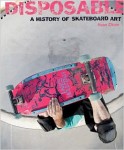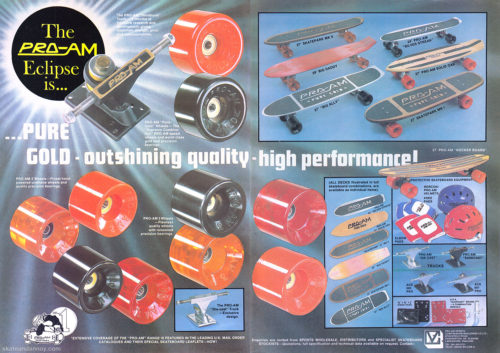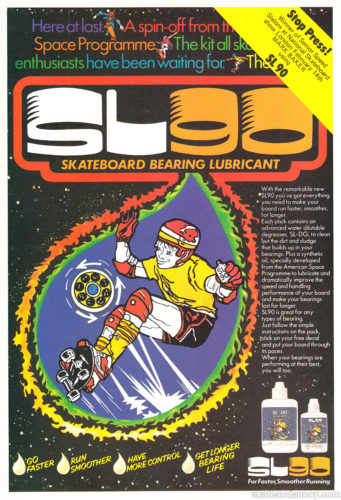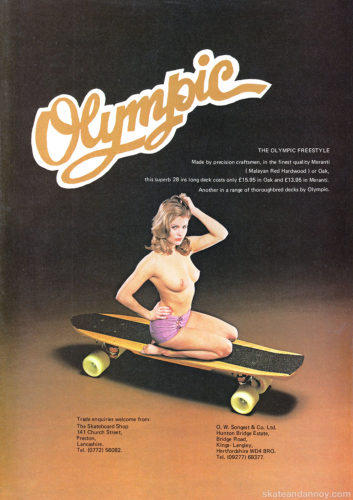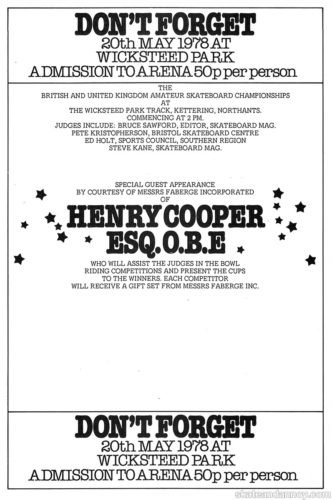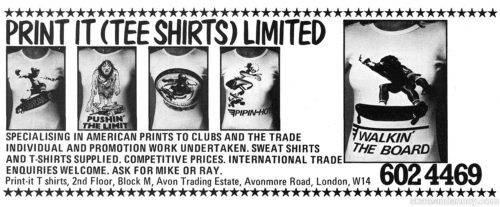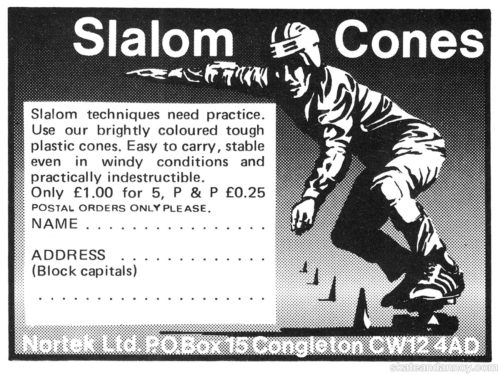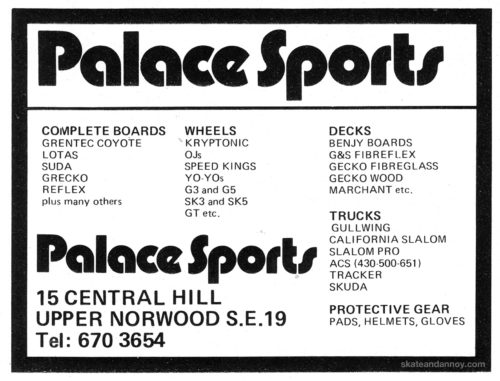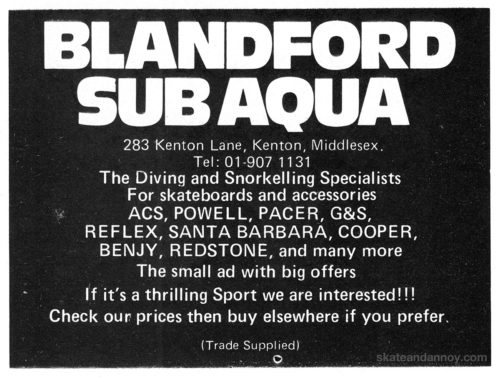Disposable: A History of Skateboard Art
Sean Cliver
Concrete Wave Editions
Copyright Date: 2004
Review Date: 2004
Updated: 4/6/2005
2004 has been a banner year for good skateboard-related books. Independent’s Built to Grind certainly raised the bar, and Disposable has stepped up to the plate. If you don’t have time read through a bunch of superfluous words I wrote in order to justify the review copy we were sent, let me skip to the point by saying Disposable is by far the best skateboard graphics book to be published so far. It’s 228 pages of color photos and accompanying text that covers 30 years of skateboard history. If a class existed for the history of skateboard art, Disposable would have to be the textbook. There are supposedly over 1000 graphics boards shown, a number which I’ll leave up to you to verify. Aside from the pictures, which thankfully are pictures and not just digital reproductions of the art, there are short to medium length recollections of the artists and riders involved that are very telling insights into the industry, popular and unpopular figures involved. Sure to please anyone who pays attention to the bottom of a skateboard or has nostalgia for boards they might have owned.
There have been a couple of other books on skateboard graphics that have met with varying degrees of success. The art of Surf Skate and Snow graphics holds the middle ground, and would be better it were not diluted with dangerously boring snowboard designs and crappy hand drawn surfboard designs. The Art of Jim Phillips is a good tome of his work, but the skateboards are only a partial element, and only one company and artist’s worth at that. There is an MTV branded book that, like all things concerned with that network, is an exercise in style over substance with nothing worth remembering. Rhyn Noll’s Skateboard Retrospective: A Collector’s Guide is a fat volume that is fun to digest but suffers from occasional lack of focus, one-sidedness, and a spotty design and layout. He also has a book called Skateboards That Rock is one I can’t comment on, but the hokey title doesn’t bode well for its contents.
Cliver states that his intent in publishing this book was to chronicle history from an insider’s standpoint in stead of another misleading or bland outsiders attempt to pander to a demographic. He certainly is in a good position to do so, having worked for a lot of the players over the years starting out as the guy who took over Powell’s art chores from V.C. Johnson. Cliver has worked for a lot of companies from World Industries during it’s creative heyday to Birdhouse. He was also the first editor of Big Brother. You might say he is uniquely qualified to put this together. Cliver’s personal voice is a welcome narrative feature.
The text of roughly the first 40% of the book is dominated by Cliver’s own recollections concerning his abrupt entry into the profession of skateboard designer and the path his decision took him. The surrounding boards and stories are roughly chronological representations of decks from various artists covering the dawn of the eighties to the millennium. Somewhere before mid-book and after a few too many anonymous World Industries and related decks, the format changes to collect the thoughts and works of a particular artist or skateboard company. Everyone that can be expected is there, from Jim Phillips, C.R. Steyck, Wes Humpston, Pushead, Mark Gonzales, Ed Templeton Swank, and Blender. Some companies are represented by the artists that defined their graphic identity like Jim Phillips did with Santa Cruz and Ron Cameron did with Blockhead. Skull Skates and in particular Brand-X are welcome inclusions of companies that may not have had a huge market share or product awareness but certainly carved out a unique place in our pastime. G.S.D. is another example.
You really should go buy this book. But now that I have told you this, it’s time for all the nitpicking and petty reasons why this book could have been better. I have a tendency to have a sliding scale for judging something. The better it is executed, the more scrutiny I subject it to.
Disposable should be in hardcover. Disposable is not a complete history. Some companies are included such as Shut which seems only notable in that it mutated into Zoo York, at the exclusion of other companies like Circle A, Seaflex, and a host of other smaller companies. In fact there are a lot of companies that seem to be missing if only because they can’t be grouped together to fit the layout of the book. Perhaps there was nobody available to comment, but the lack of Blender’s comments didn’t exclude his representation. On the graphic front, most of the pictures should have been printed at twice the size. Of course this would have made the book more expensive, but it’s little bit like buying an AM radio to listen to the symphony. Disposable doesn’t start early enough in the history of board graphics. There are too many hand-painted decks when arguably, the only ones that should be included are the original Dogtown boards that were in a sense “production” boards. Sometimes a specific model will be mentioned but it will not always be clear which photograph if any it refers too. I suspect this is chiefly due to Cliver’s close proximity to the parties involved. Deck models are identified by company, rider, and artist only. What’s missing is the accompanying model or artwork designation.
Overzealous criticisms aside, Disposable is among the best of the printed skateboard companions, both in pictures and words. Disposable’s glimpse into the inner workings of the industry reveals hidden treasures of information about riders and specific boards that the admiring public otherwise would have no way of knowing. It’s also sure to be a hit with the eBay crowd as a sort of reference guide. Available from skate shops only for the first year! How cool is that? Where do I mention the cool but curious cover shot that has copers? Right here, I guess.
Partial list of featured personalities taken from the Disposable web site: Wes Humpston, Jim Phillips, Lance Mountain, Pushead, Ed Templeton, John Lucero, Mike Hill, Chris Miller, Jason Jessee, Steve Caballero, Ron Cameron, Jim Thiebaud, Jason Lee, Garry Davis, Tod Swank, Tony Hawk, Andy Howell, Steve Rocco, Natas Kaupas, Andy Jenkins, Todd Francis, Marc McKee, Mike Vallely, John Grigley, Jeff Grosso, Jim Muir, Craig Stecyk, Eric Dressen, Todd Bratrud, Neil Blender, Claus Grabke, Jeremy Klein, Bam Margera, John Gibson, Tommy Guerrero, Mike McGill, Thomas Campbell, Barry McGee, Jef Hartsel, Corey O’Brien, Rob Roskopp, Steve Alba, Simon Woodstock, and many others.
Update: The second edition is out! The second edition has 16 new pages which include more rare Powell Peralta and VCJ images, expanded text by Jim Phillips and Bernie Tostenson, new quotes from Mullen, Hosoi, and Don Brown, 60 new deck pictures, typo and error corrections, and a heavier duty paper stock. All for the original price. Rumored to be included in the new edition are some Circle A and Seaflex pics whose exclusion was first groused about by a notable skate journalism source with an outstanding reputation… I still curse Sean Cliver for not sending out his press release in text form and making me type this stuff in by hand. If not, it sounds like I’d have nothing to complain about! The book is still available only to skate and specialty shops and will not be distributed in normal channels until November 2005.
Online action: disposablethebook.com

